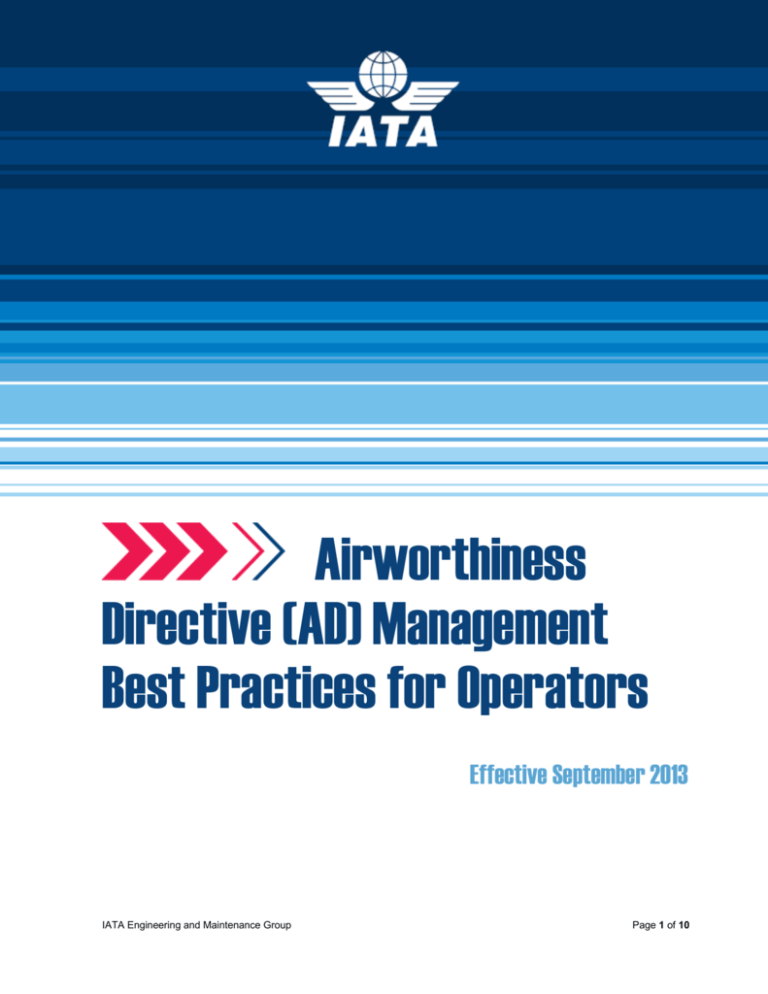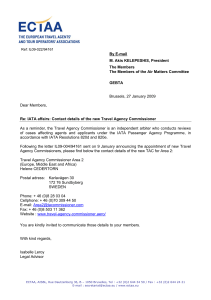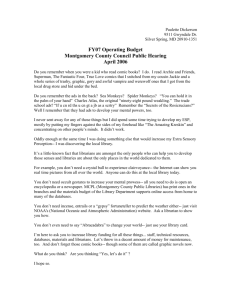Airworthiness Directive (AD) Management Best Practices for
advertisement

Airworthiness Directive (AD) Management Best Practices for Operators Effective September 2013 IATA Engineering and Maintenance Group Page 1 of 10 NOTICE DISCLAIMER. The information contained in this publication is subject to constant review in the light of changing government requirements and regulations. No subscriber or other reader should act on the basis of any such information without referring to applicable laws and regulations and/or without taking appropriate professional advice. Although every effort has been made to ensure accuracy, the International Air Transport Association shall not be held responsible for any loss or damage caused by errors, omissions, misprints or misinterpretation of the contents hereof. Furthermore, the International Air Transport Association expressly disclaims any and all liability to any person or entity, whether a purchaser of this publication or not, in respect of anything done or omitted, and the consequences of anything done or omitted, by any such person or entity in reliance on the contents of this publication. No part of this publication may be reproduced, recast, reformatted or transmitted in any form by any means, electronic or mechanical, including photocopying, recording or any information storage and retrieval system, without the prior written permission from: Senior Vice President Safety and Flight Operations International Air Transport Association 800 Place Victoria P.O. Box 113 Montreal, Quebec CANADA H4Z 1M1 IATA Engineering and Maintenance Group Page 2 of 10 Table of Contents 1. Purpose ................................................................................................................... 4 2. Background ............................................................................................................. 4 3. Business models .................................................................................................... 4 4. Challenges ............................................................................................................... 5 5. Considerations ........................................................................................................ 6 6. Description of intermediate state .......................................................................... 7 7. Description final state ............................................................................................ 8 8. Critical Success factors ......................................................................................... 9 IATA Engineering and Maintenance Group Page 3 of 10 1. Purpose This paper describes the best practices recommended for operators with respect to managing the AD process within operator’s maintenance management system. This allows operators to improve their internal processes or develop new process for AD’s management. To ensure continued airworthiness, concerns regarding ADs shall be addressed in a logical and comprehensive manner. This can be accomplished by developing a robust AD management process. 2. Background AD compliance is one of the most important requirements within the aviation industry ensuring safe flight operations. ADs are issued when an unsafe condition is found to exist in a product and the condition is likely to exist or develop in other products of the same type design. ADs are used to notify aircraft owners and operators of unsafe conditions and the actions required to resolve those conditions. Processes within the industry have been designed and implemented to ensure AD compliance. Despite stringent requirements, process design, internal and external audits, etc., industry is sometimes confronted with issues related to proper handling and processing of ADs. This is a result of several changing and more demanding environmental conditions in combination with organizational developments. For example introduction of new legislation, implementation of new IT systems, gradual deterioration of awareness of employees, etc. are the latent conditions which can trigger a risk of non-compliance with AD requirements. 3. Business models The scope of the AD process is strongly dependent on the in-house capabilities of the operator concerned. In this respect one can distinguish two business models: . 1. Maintenance is outsourced to an appropriately approved maintenance organization 2. Operator is responsible for the maintenance of operated aircraft IATA Engineering and Maintenance Group Page 4 of 10 Of course there are numerous variations in between these two business models, but they do not in principle affect the AD processes and AD process management. In the first business model the AD process is primarily concerned with AD evaluation (applicability and effectivity), providing directions in form of work order/work package to the approved organizations for implementation on aircraft, components and / or engines. In return proof of compliance in form of task cards are acquired from maintenance organizations. In essence one relies on certified and approved maintenance providers and vendors for AD requirements implementation. In the second business model the AD process has to be defined, designed, implemented, monitored and controlled by the continuing airworthiness management organization/operator. 4. Challenges Organizations might be faced with some challenges in order to demonstrate AD compliance at all times. If one or more of the following indications are noticeable or present, one should be very alert and keen on the robustness of the AD process and consequently the ability to demonstrate AD compliance: The AD process sometimes dependent upon other process like Service Bulletin execution, inspection etc. AD handling is an integration of different existing business processes. Improvements and changes to the AD process directly or indirectly affect other processes as well Complex communication and interdependencies within operator’s organization setup relevant with AD management and implementation Lack of adequate processes within the organization Duties and responsibilities not clearly defined or overlapping AD process management or control is not well defined Lack of Key Performance Indicators (KPIs), hands-overs, no closed loop and the process performance is not known Anomalies encountered in the component related work preparation and execution Lack of management involvement IATA Engineering and Maintenance Group Page 5 of 10 Lack of competent/qualified persons Lack of adequate resources Lack of awareness To overcome these challenges AD process management is required to be a continuous active process and required to cover/identify all dynamic changes in the system in order to acquire at all times AD status of aircraft current and updated with no AD over flown. 5. Considerations If operators/continuing airworthiness management organizations tend to improve their AD process, one has to establish so-called design criteria that will enable and support the definition, design and implementation of the AD process. There are many distinct internal processes, controls, and actions necessary for AD compliance planning, implementation, and auditing. The following design criteria shall be considered: The AD management process may consider an integrated approach among all departments who have a role in evaluating, defining, planning, executing and reporting compliance with an AD. Design clear hand-overs / handshakes in the process with clearly defined outputs and responsibilities Every AD shall follow the same standard process steps. Do not design and implement a process based on exceptions. The AD process shall be closed loop to enable monitoring input, throughput and output based on factual data (KPIs) Avoid checks that do not add value to the process and optimize the process One IT system should be used to demonstrate compliance, avoiding dependence on human factors Employees involved in any AD process step shall be aware of their task and responsibility and shall be trained Careful review of the AD with particular focus on any unique aspects of the AD. Does it require specific parts or articles that require long lead times? Does it impact future inspection schedules? IATA Engineering and Maintenance Group Page 6 of 10 Determining any unique product or appliance aspects. Does the AD apply to the entire fleet or only particular products or appliances? Are there repairs or alterations on the product or appliance that might require an AMOC? Evaluating the method of compliance as annotated in the maintenance records (e.g., task cards, engineering orders, engineering authorizations, etc.) to ensure AD requirements will be met Determining whether to use physical markings to identify areas where an AD is in effect Determining whether AD-referenced service instructions have already been accomplished. Also, determine if any deviations occurred from the service instructions, which would require an AMOC Determining whether there should be changes to the Aircraft Maintenance Manual (AMM), an Illustrated Parts Catalog (IPC), or a Wiring Diagram Manual (WDM) to ensure continued compliance Ensuring rotable spares and work performed in the shop are AD compliant Determining the need for training and specific labour skills (e.g., avionics, Non-destructive Testing (NDT), structures, etc.) Determining the restriction of AD accomplishment to site-specific locations Determining the need for an enhanced perspective (i.e., a second set of eyes) at the point of implementation Determining when and how audit plans will be impacted for ADs that call for segmented actions Determining whether prototyping is needed and, if so, the persons or departments that will accomplish that process 6. Description of intermediate state If organizations feel the need to improve the AD process, the desired final solutions should be clearly defined. However, implementation of final process could take quite some time. Immediate action will be required. In this case, intermediate solutions could be implemented that are effective but may not be robust in the long run. An example of an intermediate solution is described below. IATA Engineering and Maintenance Group Page 7 of 10 A dedicated AD Office should be put in place to check the proper execution of every AD that is issued and is applicable and effective and to demonstrate AD compliance per tail. Direct escalation and line of command to the Accountable Manager should be established AD review and evaluation should be checked 100% In execution spot checks are performed AD record for active ADs is set up and maintained Discipline and awareness by the employees should be actively increased by means of communication, training, on the job training, etc. IT support tool should be designed and implemented to monitor and report the AD process performance. Amongst others reports it should include the number of new ADs, the stage where they are in, and qualitative and quantitative AD issues. 7. Description of final state Redesigned, robust AD management system. The AD process should incorporate many existing processes, i.e. service bulletins, job card creation, planning, supply chain, execution, inspections, audit, quality assurance reporting, etc. The AD process should be closed loop to ensure positive feedback with respect to accomplishment of the AD A monitoring IT tool should remain in place as well as dedicated attention for ADs The hierarchical line management remains responsible for proper execution of their part of the process. One process owner is appointed to manage the process (monitoring, interface control, improvements, KPIs). The role and responsibilities of the process owner is key for the success of the newly introduced AD process. The following items are the cornerstones for a proper functioning process owner: o Monitoring overall AD process performance based on factual data (KPIs) o Analyzing, initiating and control of process improvements o Monitoring co-operation between departments involved in the AD process and identifying potential issues o Monitoring and assessment of AD process related process changes o Ability to escalate issues as they arise IATA Engineering and Maintenance Group Page 8 of 10 The AD process owner has an independent position in the organization, and has direct access to the Accountable Manager. Escalation should take place in case of: o Issues with co-operation between departments involved, o No involvement of affected departments, o Integral process issues. Every new AD will be assessed in order to determine the threats related to proper processing of the AD. A multi-disciplinary team consisting of Engineering, Production, Material Management, etc. will determine: o Implementation time between effective date and due date emergency ADs o Number of departments involved in AD processing o ADs applicable for airplanes with effects on components and / or engines o Complex AD limit requirements in combination with conditional tasks o Off standard AD requirements, e.g. feedback AD accomplishments to authorities o Terminating action vs. ongoing inspection o Embodiment of ADs on aircraft in storage o Planning ADs with long compliance time Record keeping, phasing out and AD monitoring is combined in one centralized department 8. Critical Success factors To be able to achieve the required AD proof of compliance in conjunction with the objectives defined to implement a robust, effective and efficient AD management process, the following critical success factors should be taken into account: Overall AD process management interests prevail above individual / local AD process steps. AD process owner is independent and has direct access to Accountable Manager and is mandated to implement AD process improvements. KPIs and supporting IT tool to be used for measuring and follow up of AD process performance Top management involvement Adequate training and qualification of staff involved Well established communication internal as well as external Clearly defined duties and responsibilities IATA Engineering and Maintenance Group Page 9 of 10 Overall awareness of persons involved Identification of weak areas and improvement areas through a systematic audit setup Taking appropriate corrective and preventive action against the outcome of audits Lessons learned from experience IATA Engineering and Maintenance Group Page 10 of 10






